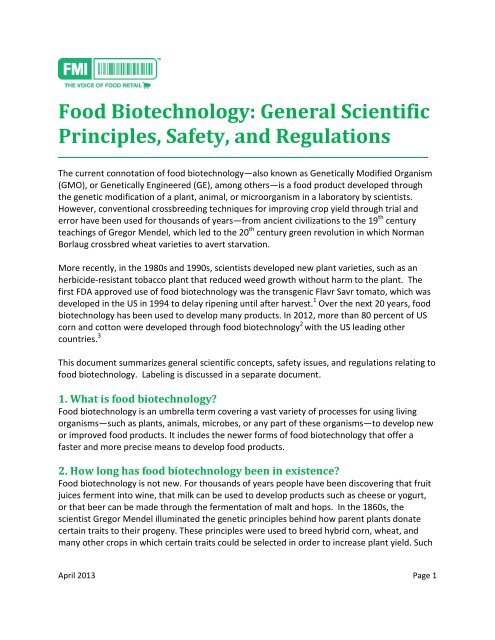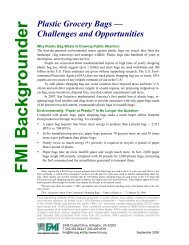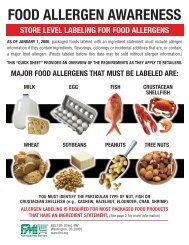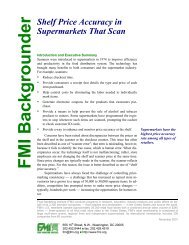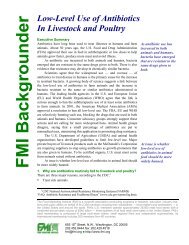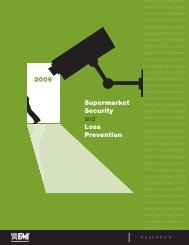Food Biotechnology - Food Marketing Institute
Food Biotechnology - Food Marketing Institute
Food Biotechnology - Food Marketing Institute
Create successful ePaper yourself
Turn your PDF publications into a flip-book with our unique Google optimized e-Paper software.
<strong>Food</strong> <strong>Biotechnology</strong>: General ScientificPrinciples, Safety, and RegulationsThe current connotation of food biotechnology—also known as Genetically Modified Organism(GMO), or Genetically Engineered (GE), among others—is a food product developed throughthe genetic modification of a plant, animal, or microorganism in a laboratory by scientists.However, conventional crossbreeding techniques for improving crop yield through trial anderror have been used for thousands of years—from ancient civilizations to the 19 th centuryteachings of Gregor Mendel, which led to the 20 th century green revolution in which NormanBorlaug crossbred wheat varieties to avert starvation.More recently, in the 1980s and 1990s, scientists developed new plant varieties, such as anherbicide-resistant tobacco plant that reduced weed growth without harm to the plant. Thefirst FDA approved use of food biotechnology was the transgenic Flavr Savr tomato, which wasdeveloped in the US in 1994 to delay ripening until after harvest. 1 Over the next 20 years, foodbiotechnology has been used to develop many products. In 2012, more than 80 percent of UScorn and cotton were developed through food biotechnology 2 with the US leading othercountries. 3This document summarizes general scientific concepts, safety issues, and regulations relating tofood biotechnology. Labeling is discussed in a separate document.1. What is food biotechnology?<strong>Food</strong> biotechnology is an umbrella term covering a vast variety of processes for using livingorganisms—such as plants, animals, microbes, or any part of these organisms—to develop newor improved food products. It includes the newer forms of food biotechnology that offer afaster and more precise means to develop food products.2. How long has food biotechnology been in existence?<strong>Food</strong> biotechnology is not new. For thousands of years people have been discovering that fruitjuices ferment into wine, that milk can be used to develop products such as cheese or yogurt,or that beer can be made through the fermentation of malt and hops. In the 1860s, thescientist Gregor Mendel illuminated the genetic principles behind how parent plants donatecertain traits to their progeny. These principles were used to breed hybrid corn, wheat, andmany other crops in which certain traits could be selected in order to increase plant yield. SuchApril 2013 Page 1
International used a gene from the Brazil nut containing complementary levels of methionine toimprove the protein quality of the soybean. An article in the New England Journal of Medicinedemonstrated that these soybeans enhanced with genes from the Brazil nut caused allergicreactions in sensitive people. 5 Pioneer Hi-Bred International decided not to market the soybeanand is looking for alternative sources of the protein.Supporters of food biotechnology and federal regulators might see this as an example of thesystem at work. The soybean was tested for allergic responses before the seed went to market;when such responses were identified, the supplier withdrew the product and worked todevelop a nonallergenic food.For critics of food biotechnology, this example might reaffirm concerns, as the transfer ofallergens from one food to another is no longer hypothetical. Although the fortified soybeanwas not marketed, concern remains.6. How does FDA review products developed through foodbiotechnology?In 1992, the US <strong>Food</strong> and Drug Administration (FDA) developed a guidance document entitled“<strong>Food</strong>s Derived from New Plant Varieties” that requires a food product, including thosedeveloped through food biotechnology, to be labeled if it is significantly different from whatoccurs in a standard product. For example, if wheat gluten was introduced into a potato, itslabel would require a warning for sensitive populations with celiac disease. Furthermore, FDAhas developed the following assessment:• Have the levels of any naturally occurring toxins in the plant been increased?• Has an allergen not commonly found in the plant been introduced?• Have the levels or bioavailability of nutrients changed?• Have new substances been introduced into food that raise safety questions?• What are the environmental effects?• Have accepted, established scientific practices been followed?More recently, in 2011, FDA released a guidance document, “Regulation of GeneticallyEngineered Animals Containing Heritable Recombinant DNA.” Under the Federal <strong>Food</strong> Drug andCosmetic Act (FFDCA), the biotechnology process to alter the structure or function of the bodyof an animal, regardless of the intended use of products, is considered a “new animal drug” and isregulated through similar assessments as those for plants listed in the above bullet points.There is no absolute requirement, however, that products developed through foodbiotechnology undergo premarket review unless a substance was introduced into the food andis not generally recognized as safe (GRAS) per Section 409 of FFDCA. Companies are voluntarilysubmitting new products to FDA for review. FMI supports the FDA review process.April 2013 Page 3
7. How does the EPA regulate food developed through biotechnology?The US Environmental Protection Agency (EPA) develops standards for pesticide use and humanexposure. In the case of plant biotechnology, EPA considers many factors regarding a PlantIncorporated Protectant (PIP), which is the use of biotechnology to control crop pests in lieu ofa pesticide. Those factors include:• Studies assessing risk to human health• Studies assessing risk to non-target organisms and the environment• The potential for gene flow (biotech crop traits transferring to non-biotech crops)• The need for insect resistance management plans8. How does the USDA regulate products developed through foodbiotechnology?The US Department of Agriculture (USDA) regulates the products developed through foodbiotechnology but not the process itself. USDA’s Animal and Plant Health Inspection Service(APHIS) regulates the safe introduction (environmental release, interstate movement, andimportation) of plants and animals developed through biotechnology. APHIS has responsibilityfor assessing the ecological effects of new plants developed through biotechnology under thePlant Protection Act of 2000.9. What has been the consumer reaction to products developed throughfood biotechnology?There has been much research in numerous countries on consumer opinions regarding foodproducts developed through biotechnology. For example, a 2003 study reports US consumersare willing to pay 15-30 percent above base price to avoid food products developed throughbiotechnology. 6 A 2005 study concluded that the greatest concerns of US consumers regardingfood production were pesticides, hormones, and antibiotics, followed by food ingredientsdeveloped through biotechnology. 7 More recently, a report on consumer perceptions of foodbiotechnology showed that over two-thirds of Americans are confident in the safety of the USfood supply, and that the main barrier to the acceptance of products developed throughbiotechnology is lack of information. 8Consumer awareness is on the rise, primarily due to increased media coverage and proposedlegislation such as the genetic labeling Proposition 37 in California, which was not passed intolaw in 2012. It is anticipated that proposed legislation will continue.10. How have consumer and environmental advocates responded toproducts developed through food biotechnology?Several environmental and consumer advocacy groups believe that products developedthrough food biotechnology introduce food and environmental safety risks that warrantpremarket testing and review. These groups are concerned with human health effects includinghigher risks of toxicity, allergenicity, antibiotic resistance, immune-suppression, and cancer.April 2013 Page 4
The New England Journal of Medicine's report 5 of an allergen transferred in soybeans enhancedwith genes from Brazil nuts strengthened their concerns.Advocacy groups discuss fears of antibiotic resistance transferring from plants to human gutmicroorganisms through antibiotic gene markers used in the plant biotechnology process. Eventhough evidence of this transfer phenomenon is lacking, researchers are developing alternativemethods which use metabolism markers in lieu of antibiotic ones. 9Environmentalists fear that more pest-resistant crops, such as Bt Corn, which is developed withthe use of biotechnology to control crop pests, will lead to the evolution of highly resilient pestsor weeds that pose a threat to all crops, particularly organic ones, and harm the environment.In addition, organic farmers do not want their crops cross-pollinated with crops developedthrough food biotechnology.For reasons stated above, as well as others, advocates have called for a ban on productsdeveloped through food biotechnology or at least a moratorium on further development untilsafety and environmental issues can be more thoroughly researched.11. What positions are other countries taking regarding productsdeveloped through food biotechnology?The European Union (EU) has tight requirements on the approval and labeling of productsdeveloped through food biotechnology. Regulation (EC) No 1829/2003 requires a company toapply for authorization to grow and sell products developed through food biotechnology.Within 14 days of receiving the application, the national authority notifies the European <strong>Food</strong>Safety Authority (EFSA), which is responsible for performing a risk assessment within 6 months.Once approved, food and feed products developed through food biotechnology must beidentified on the label. Approvals are valid for ten years. 10Certain jurisdictions in Japan, UK, Australia, New Zealand, and Canada also require premarketsafety inspections for foods developed through biotechnology. 11Some countries have resorted to outright bans of GM foods. In November of 2012, Kenyabanned products developed through food biotechnology. Per the cabinet, "The ban will remainin effect until there is sufficient information, data and knowledge demonstrating that GMOfoods are not a danger to public health." 1212. What organizations are using food biotechnology in order to improvepublic health worldwide?HarvestPlus, a non-profit organization supported through the Bill and Melinda GatesFoundation, donates funds for studies that use food biotechnology in order to fortify a staplecrop like cassava or rice with essential micronutrients such as vitamin A, through intake of betacarotene.13 HarvestPlus is partnered with the Consultative Group on International AgriculturalApril 2013 Page 5
Research (CGIAR), which is associated with government and research organizations worldwide,in the effort to use food biotechnology to reduce suffering in Africa and Southeast Asia fromthe inadequate intake of essential nutrients such as vitamin A, zinc, and iron. 14Both the World Health Organization (WHO) and the <strong>Food</strong> and Agriculture Organization (FAO), ofthe United Nations, assess food biotechnology as a tool that can be used to reduce hunger,improve food quality and sustainability if safety, environmental, methodology, and ethicalconcerns are addressed.13. What is the grocery industry's position regarding productsdeveloped through food biotechnology?The grocery industry believes that it is the role of the federal government to establish andenforce standards that ensure the safety of our nation's food supply. National uniformity andconsistency are imperative in the development and enforcement of food safety laws governingfood from production to consumption. FMI supports FDA's review process for productsdeveloped through food biotechnology. FMI policy on food biotechnology is addressed here:http://www.fmi.org/docs/policy-statements/genetically-modified-food-andbiotechnology.pdf?sfvrsn=6.April 2013 Page 6
13Katz, J. M., M. R. LaFrano, C. K. Winter, B. J. Burri. Modelling potential B-carotene intake and cyanide exposurefrom consumption of biofortified cassava. Available at:http://journals.cambridge.org/action/displayAbstract?fromPage=online&aid=8851763&fulltextType=RA&fileId=S2048679012000304. Accessed 16 April 2013.14 Consultative Group on International Agricultural Research. 2013. Available at:http://www.a4nh.cgiar.org/about/. Accessed 16 April 2013.April 2013 Page 8


